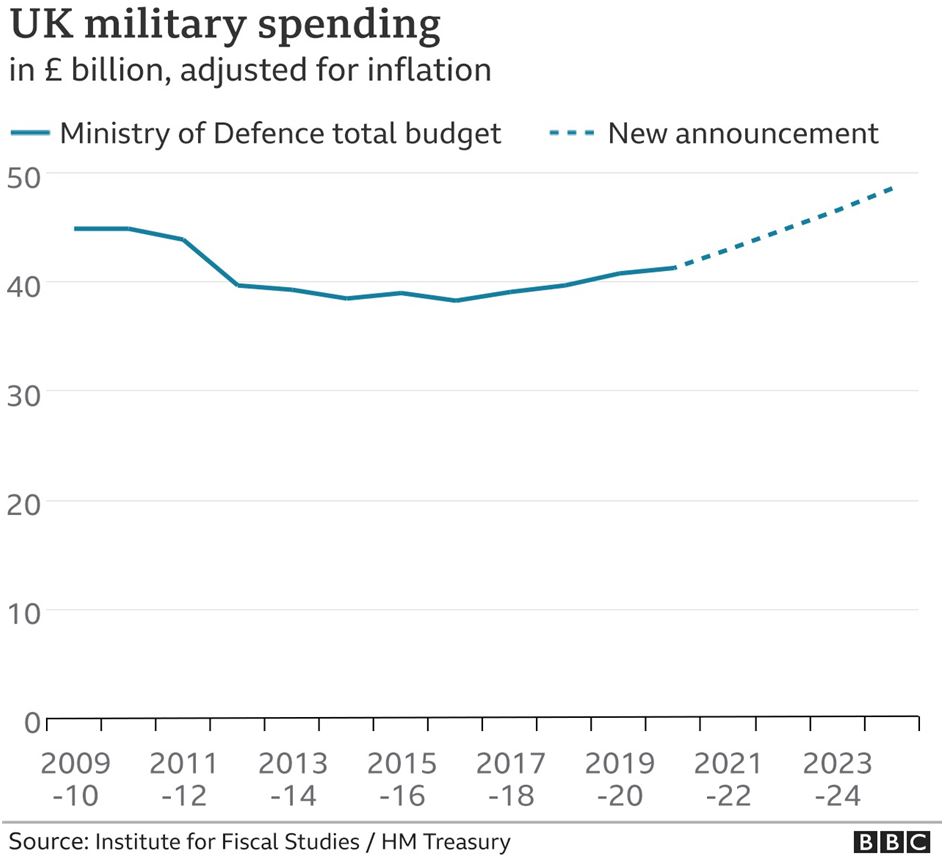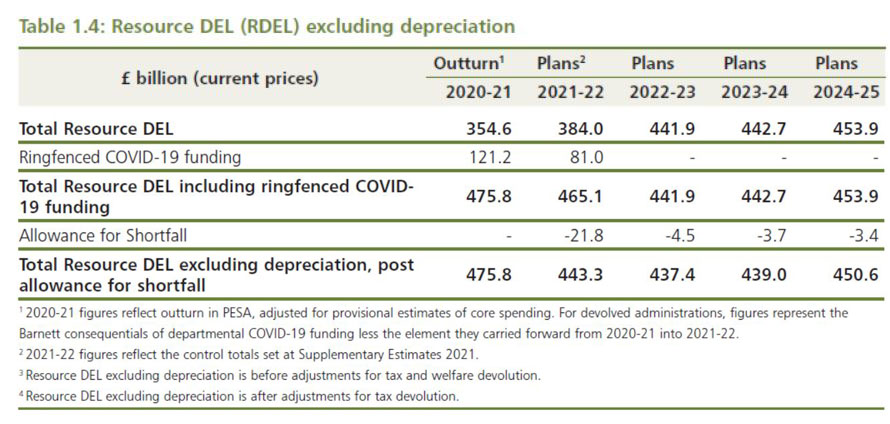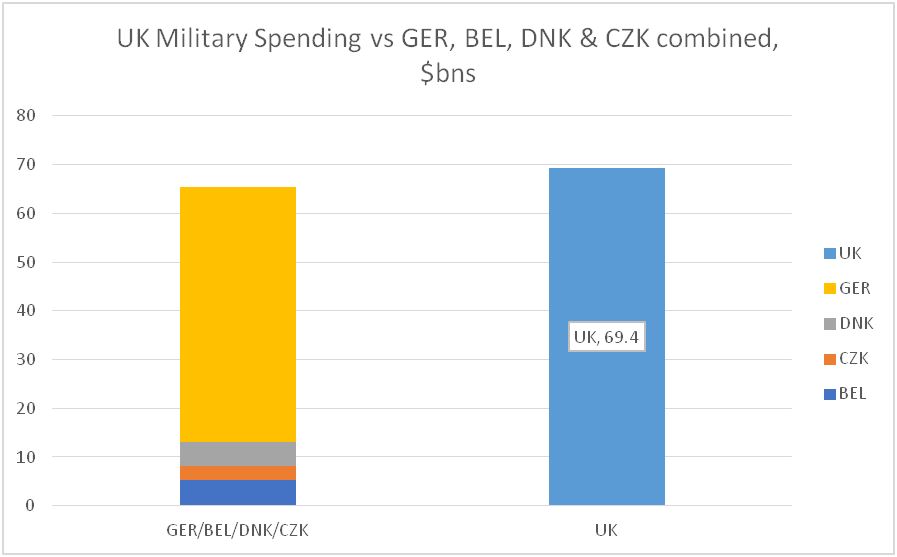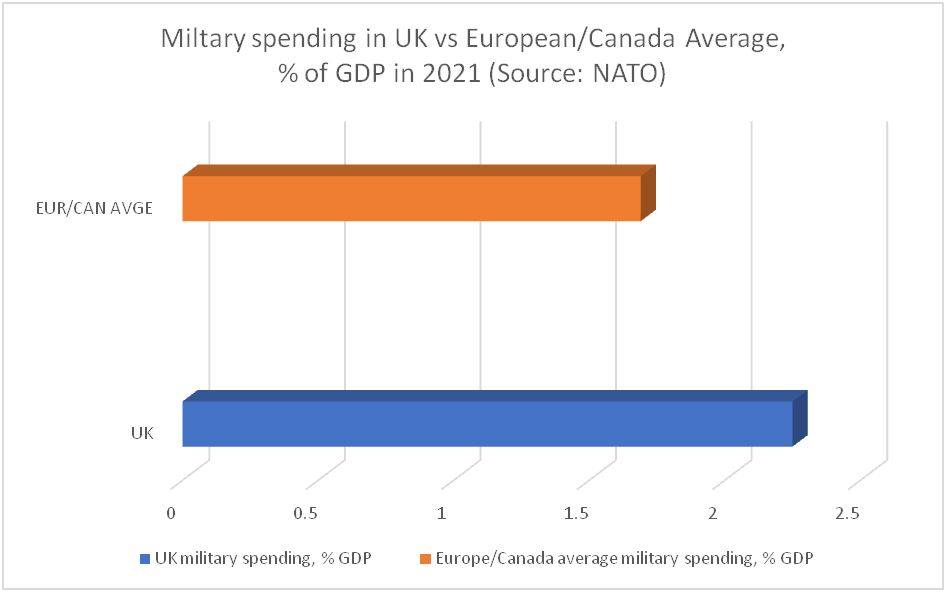By Michael Burke
The call by the British defence secretary Ben Wallace for an additional £11 billion for the military budget highlights the priorities of a government. This is at the same time it is imposing huge cuts in real pay to millions of public sector, and hoping this will help keep private sector wages down.
The clear response from the labour movement and all progressive forces should be the demand for inflation-plus wage increases and for cuts to the military budget – #wagesnotweapons.
The military budget comes first
It is already the case that the British military budget was exempt from the swingeing cuts made in the last Budget in March 2022, by the then Chancellor Sunak. The chart below shows the projected outturn for the defence budget made at that time.
As the chart specifies, this is an increase in real terms (after inflation) from £41 billion to £48 billion. This is a rise of 17% in just 2 years.
Chart1. Trend in UK Military Spending, real £bn

This was at a time when departmental spending in areas such as health and education where being cut in real terms, once one-off funding for Covid-related spending was excluded.
The table below shows how the government presented its spending plans at that time. Crucially it shows ‘Total Resource Departmental Expenditure Limits, including ringfenced Covid19 funding’ as £475.8 billion in 2020-21 falling to £465.1bn in 2021-22, and lower every year following.
This is a significant cut in total spending, especially as the population is growing. But these are nominal totals and take. no account of inflation. Given that consumer price inflation was an average of 9.1% of the course of 2022, these departmental spending total represent a real cut of over 12%.
Of course, projections are not the same as outturns. It may well be that many departments were forced to go over their spending limits because of very high inflation over the current financial year. The March Budget this year will provide that detail.
Yet it is clear that the government policy has already been to increase defence spending in real terms, while cutting spending on the NHS, education and other public services on the same basis.
At the same time, a key plank of Wallace’s demand for more money is the fact that inflation was much higher than anticipated. But this is exactly the argument that government ministers use to deny wage increases, that they are unaffordable and will only add to inflation. The hypocrisy is stark.
Table 1. Spending Cuts in the Spring 2021 Budget

Source: UK Treasury, Spring Statement 2022 (pdf)
Outsized British military spending
Britain already has by far the second-largest military spending of the NATO countries, only behind the US. In terms of constant prices and exchange rates, UK military expenditure amounted to $69.4bn in 2021.
This is dwarfed by NATO’s principal military power, the US which spent $725.7 billion on the same basis (all data taken from the NATO secretary-general’s Annual Report 2021 unless otherwise stated).
But the true scale of the outsized nature of the UK defence budget is that the next highest total spending is Germany’s, which is both richer and has a larger population than Britain. The German total was $52.5 billion. Startlingly, the British total expenditure was the same as Germany, Belgium, Denmark and the Czech Republic combined in 2021.
Chart 2. UK’s Military Spending Exceeds Germany, Belgium, Denmark, Czech Republic combined, US$bn

Source: NATO
The same pattern is evident using the measure of defence spending as a proportion of GDP. US military was a gargantuan 3.57% of GDP in 2021. But this is far in excess of any other NATO member both in relative and absolute terms.
British military spending was 2.25% of GDP in 2021. Of the other 28 NATO member countries, only two countries spent a greater proportion of GDP on the military budget, Poland and Greece. If the European countries as a whole are grouped together along with Canada (as NATO does for the purposes of its own expenditure analysis) the average expenditure amounts to a much more modest 1.69% of GDP. This implies that the UK budget could be cut by a quarter and still be in line with the Europe/ Canada average level of military spending.
Chart 3. Military spending in UK versus Europe/Canada, 2021, % of GDP

Source: NATO
Cut spending to the EUR/CAN average
The calls for an extra £11 billion for the military should be completely rejected. It is a bad joke to claim public sector workers’ pay rises are unaffordable or inflationary while proposing this enormous extra sum for the military budget.
Scaling back Britain’s military budget is entirely feasible. Funding could be cut by a quarter. This would then bring it into line with the EUR/CAN NATO average.
In the current period the trend in policy making has been in the opposite direction. Ministers claim public sector is unaffordable and inflationary while protecting and promoting the military budget. The population is being asked to make sacrifices for war, in terms of higher energy bills and in reductions to non-military spending. Recently, the Danish government has tried to cut a holiday day ‘to pay for the war effort’. This is an extreme example of a general trend.
The left and progressive forces can turn the tables on this issue. Ordinary people’s interests lie with peace. At the same time, the government is misdirecting public spending including on the military, while public services and public sector workers are starved of funds.
The appropriate response is to cut the military budget, not the public services budgets. Our demands should be no extra military spending, and cut the existing budget to the EUR/CAN level, saving £7 to £8 billion. Pay public sector workers, not arms’ manufacturers. Fund wages not weapons.

Recent Comments